Kumbalangi , a “model village “in Kerala
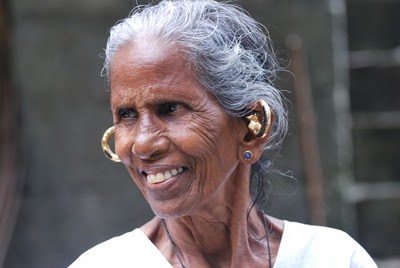
As a travel writer , it is difficult to say everything that is on your mind , especially when you are writing a story or a column for a publication .While I rarely endorse a destination unless I really liked it, I tread the middle ground when I write . I focus largely about what interested me about a place and sometimes omit the not so good experiences, unless I believe otherwise..Sometimes, the omitted bits do not fit into the story, as it ends up being a ramble. And if the experience was not worth writing about, then I do not write about it at all.
Kumbalangi on the other hand was a mixed bag. If you read my earlier post, I mentioned the dilemma I was in while writing about Kumbalangi in my column. I did not get too excited with the concept of the ” model tourism village “, at least the way it was implemented in Kumbalangi. As many mentioned , it was rather artificial . But I am all for sustainable rustic tourism and I would prefer experiencing a village and its way of life, rather than have activities arranged for me.
But I liked the place and the conversations I had with some of the locals – so I decided to go ahead and write about those aspects..Either ways, I had to stick to a word count of 500 words and so, I wrote what I thought was necessary..Nevertheless, I felt that I should actually pen down the entire experience here and leave it to you to take a call whether you would like to visit the place or not.
It started raining heavily just as I stepped into the car. My driver smiled when I told him that my destination was Kumbalangi, a small coastal village on the outskirts of Kochi. “ I studied there, “ he said, and his grin became wider as he spoke about his childhood. I asked him for more information and he gave me a brochure which called it “ an integrated model tourism village which promised authentic rural experience .” I just hoped that it would not be another tourist trap as we drove down crossing by St Josephs School and church and drove into an entire green country
Kumbalangi lived up to its promise of being part of God’s own country. Ringed in by Chinese fishing nets, the backwaters painted a pretty picture. A lone cormorant basked in the sun, while a woodpecker chipped away at the bark of a coconut tree. A few houses were scattered around while a couple of old unused coir units were lost amidst the farms.
There was no one in sight..Small lanes intersected with canals as we just roamed around aimlessly. My driver asked me what I wanted to ” do.” I mentioned I had no real agenda and wanted to meet a few locals and talk to them. He looked a bit puzzled, but drove towards the village. We met a fisherman who asked me if I was interested in fishing. As I walked with him to the jetty, we talked about Chinese fishing nets and karimeen fishing.” Sometimes we cover branches of small trees that are immersed in water by nets . After weeks, we find a variety of fish caught in them” he added.
As I wandered aimlessly around the village, speaking to locals , I noticed that almost every house had orchids growing in them. I learnt that Kumbalangi is known for pokkali farming. “ It is an organic way of cultivation,” translated my driver , explaining that the farming is normally done in the water logged areas. The farmers alternate between rice and fish or prawns, based on the salinity of the water. I didnt understand much of this when they explained in bits and pieces in Malayalam, but a bit of googling helped later.
We went to a home stay and there we heard that everything is arranged only for tourists who stay with them..That explained the empty coir units as well. I requested if I could visit their crab farm and the hostess said that I could just go over and see. I followed my driver as he took me towards a couple of big ponds lying adjacent to each other.
We met Das there, who was happy to show us his collection of crabs and explain the process of “ njandu krishi” or crab farming . “In these ponds alone, they are close to 2 lakh crabs, “ he mentioned as he carefully caught a crab only to throw it back in the pond .” It has only water as of now, not much of meat,” he explained as another small crab crawled near his leg.He had a basket full of crabs and he even explained little details about them.. Das added that crabs are exported to Hong kong, US and to many other countries and business was rather good. Das mentioned that he was Tamil Nadu and he was told not to speak to any tourist who is not staying here and he hoped we wouldnt mention it. Incidentally he did not ask for money.We left him to his crabs and moved on .
We spent a few more hours talking to many locals who were amused at the attention given to them. Old Elizabeth was very happy when I took her picture and she mentioned that a couple of foreigners had done the same as well. She cracked up as a couple of other women told her to pose and she mentioned about how pretty she looked in her youth. Her golden earrings, she mentioned were very characteristic of her community – The Latin Catholics and so was the dress she was wearing..When I thanked her, she said , ” What only thanks..Nothing else ? I smiled and we got talking with another family . I asked them a bit about Kumbalangi and they said, there is nothing really here ..just walk around, relax – there is fishing and lots of foreigners come over.
But they all had just one lament.” You hardly find any village in Kerala now everything has changed, “ they muttered as I took their leave. It was indeed true as the entire skyscape changed in a matter of minutes. ,
A part of the story was published in my column , Inside Story on Metro Plus yesterday . So, there you have my take on the model village..sometimes I think they could have created a carnival of sorts and put a price on each activity and mentioned that it was for the villagers rather than create a concept like this.

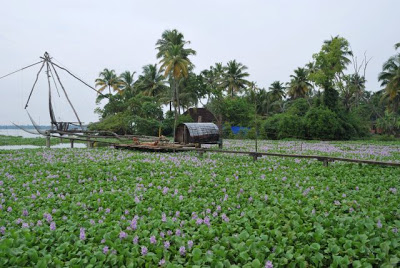
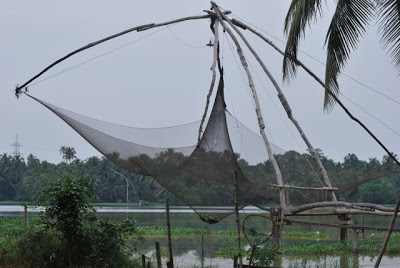
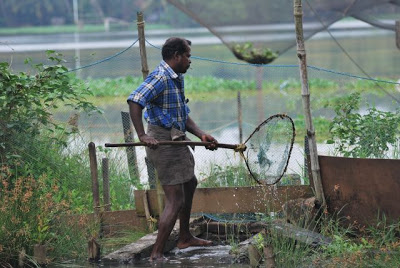

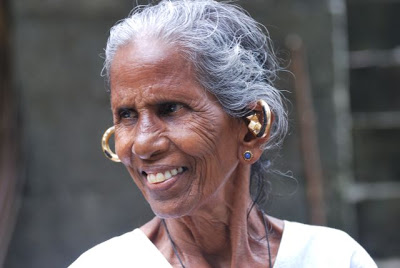
Hi Lakshmi! Lovely place and beautiful post!!
The old Thebes (Ouaset, The Powerful) is on Blogtrotter Two waiting for you!! Enjoy and have a great Sunday and week ahead!
Well written, Lashmi…. taken with the article published, i guess it is a great example of how one should write when one is not really convinced about a place! most of us would have come across such situations at some time or the other…
i esp liked the statement about there being no real villages in kerala anymore… how true… but in spite of all the commercialisation, i guess most of the people are still simple villagers at heart – like the guy who spoke to you inspite of being told not to talk to non-residents! and finally, its the people who make up a village, and it is they who make the place what it is.. what you enjoy (or dislike) when u visit a place!
as to the carnivals, i am sure there are some like that already!!
Thanks Gil, hopping over in some time
Anu – Thanks..I did like Kumbalangi, but its no ” model” village ..just another quiet place..however why I mentioned the bit abt the carnival is that its better to have tourism printed up front than package an empty concept like this
Wonderful write up. There are still virgin villages in the middle and Northern parts of Kerala which have not been exposed to the tourism oriented commercialization.
kumbalangi sounds like a not yet spoilt village…. beautiful pic 🙂
Hi Lakshmi,
I have heard a lot about kumbalangi and its natural beauty. Yet to visit it though. Its a lovely place to enjoy fishing and the backwaters.
Nomad
http://www.rajniranjandas.blogspot.com
Hi Lakshmi,
We homestay entrepreneurs never said or market Kumbalangi as a ‘model village’.It is what our great politicians said for their own sake
The subject of your photos are unusual. whatever said, the unpolluted air in the interiors of kerala is really worth the trip money. But lakshmi, EVen as i am writing this, I hope nobody finds a way to capture and market them as well.
Your conversations in the post took me virtually to the village. LOVely post and lovelier clicks.
That is a nice account of the Kumbalangi..
Ram
If you are the exploring ‘on your own’ kind and seeking to see places as they exist, I think it is better to go such places that are not advertised to tourists.
Very good text and interest views on travelling. Gorgeous photos. Congratulations!
Just came across your blog! I love to travel, so I find it very interesting!
xoxo,
colormenana.blogspot.com
We can just look into model village but each village has its own charm and only those experiences it could catch it. Liked this explain in more detail that took place in the column. As u mention finally, many things are changing widely and villages aren’t left to and they don’t know what worth they are unless seeing it from away.
what a crab!!!
hmmmmmmmmmmmmm…that over commercializing the model village concept…but i guess the views must be lovely…
Thanks for such an informative article, it’s been very useful.
Lakshmi, you have done a nice balancing act on this article and the context you shared. Unfortunately tourism is set to go this way as more and more people can “pay” to experience “authentic culture”. On the other hand, perhaps its good to have such places – so that the standard tourists will leave other places alone.
hi Lakshmi, it is very nice to read…. good snaps. thanks for the information.
There is obviously a lot to know about this. I think you made some good points in Features also. Keep working ,great job!
Hi..going to visit there..find ur words ..helpful yhanx…